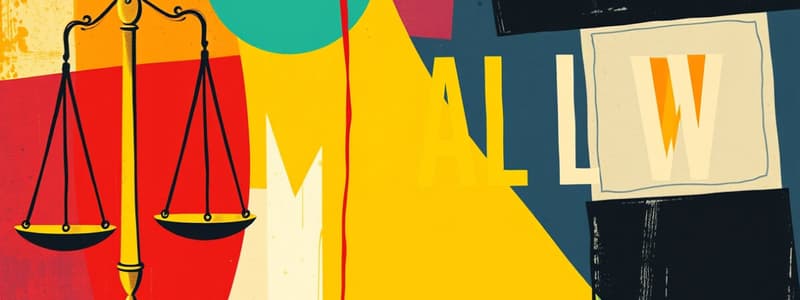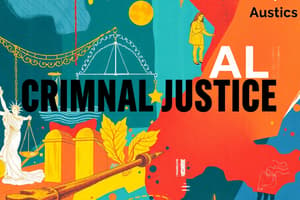Podcast
Questions and Answers
Criminal law may be classified into which two major categories?
Criminal law may be classified into which two major categories?
- Adjective (procedural) (correct)
- Substantive (correct)
- Civil
- Administrative
Name three penalties for committing a crime.
Name three penalties for committing a crime.
Fine, Imprisonment, Death
What does stare decisis mean?
What does stare decisis mean?
Adhering to precedent
What is the statute of limitations for most misdemeanors?
What is the statute of limitations for most misdemeanors?
In which court was the case citation people v. Jones, 65 Cal App 2d 381 decided?
In which court was the case citation people v. Jones, 65 Cal App 2d 381 decided?
Name three officers that the California state attorney general must give a written opinion to when requested.
Name three officers that the California state attorney general must give a written opinion to when requested.
Name three areas that the state may pass laws under the doctrine of police power.
Name three areas that the state may pass laws under the doctrine of police power.
Name three sources of criminal law in this country.
Name three sources of criminal law in this country.
Venue has to do with the courts' ____________ location.
Venue has to do with the courts' ____________ location.
What was one of William the Conqueror's most lasting contributions to modern criminal justice?
What was one of William the Conqueror's most lasting contributions to modern criminal justice?
In the case citation Reeler v. Superior Court, what does 87 refer to?
In the case citation Reeler v. Superior Court, what does 87 refer to?
What term relates to crimes involving falsification, such as perjury and forgery?
What term relates to crimes involving falsification, such as perjury and forgery?
The court's legal authority to hear a case is referred to as its __________.
The court's legal authority to hear a case is referred to as its __________.
Criminal acts that are considered to be wrong or evil in themselves are referred to as __________.
Criminal acts that are considered to be wrong or evil in themselves are referred to as __________.
What is the French term that also means a civil wrong?
What is the French term that also means a civil wrong?
What principle binds courts to stand by prior decisions?
What principle binds courts to stand by prior decisions?
A plea of __________ cannot be used against a defendant as an admission of wrongdoing in civil suits.
A plea of __________ cannot be used against a defendant as an admission of wrongdoing in civil suits.
In a civil action, the plaintiff is the person who __________.
In a civil action, the plaintiff is the person who __________.
The definition of crime and punishment, not the procedural or adjective component, is referred to as __________.
The definition of crime and punishment, not the procedural or adjective component, is referred to as __________.
What are the two types of opinions rendered by the attorney general?
What are the two types of opinions rendered by the attorney general?
What term means the evidence is valid on its face for a conviction?
What term means the evidence is valid on its face for a conviction?
What is the maximum sentence that one can serve for a misdemeanor?
What is the maximum sentence that one can serve for a misdemeanor?
A Malum prohibitum crime is wrong because it is __________ by law.
A Malum prohibitum crime is wrong because it is __________ by law.
Stare decisis essentially means let the __________ stand.
Stare decisis essentially means let the __________ stand.
The statute of limitation for a misdemeanor is generally __________.
The statute of limitation for a misdemeanor is generally __________.
Name three crimes that have no statute of limitations.
Name three crimes that have no statute of limitations.
The person who files an appeal is known as an __________.
The person who files an appeal is known as an __________.
The adverse party in an appeal is known as an __________.
The adverse party in an appeal is known as an __________.
How many justices are in the California Supreme Court?
How many justices are in the California Supreme Court?
How many appellate districts are there in California?
How many appellate districts are there in California?
In California, 'common law' crimes exist.
In California, 'common law' crimes exist.
Controlling criminal law may be found in three sources. Name them.
Controlling criminal law may be found in three sources. Name them.
In California, 'public offenses' are of three types. Name them.
In California, 'public offenses' are of three types. Name them.
The concept of 'stare decisis' means that courts generally follow __________ decisions.
The concept of 'stare decisis' means that courts generally follow __________ decisions.
The statute of limitations applies to __________ a prosecution.
The statute of limitations applies to __________ a prosecution.
An 'ex post facto' law would be one that criminalizes previously __________ conduct after it was committed.
An 'ex post facto' law would be one that criminalizes previously __________ conduct after it was committed.
Flashcards are hidden until you start studying
Study Notes
Criminal Law Classifications
- Criminal law is divided into two major categories: Substantive and Procedural (adjective).
Penalties for Crime
- Common penalties for crimes include Fine, Imprisonment, and Death.
Stare Decisis
- The principle of stare decisis advocates for fixed and known laws, focusing on adhering to precedent, although courts may not always rigidly follow it.
Statute of Limitations
- The limitation period for most misdemeanor offenses is 1 year.
Case Citations
- The citation People v. Jones, 65 Cal App 2d 381 indicates a decision made in the California Appellate Court.
Attorney General's Opinions
- The California state attorney general provides written opinions upon request from:
- Secretary of State
- Governor
- Superintendent of Public Instruction
Police Power Laws
- States can legislate on issues related to:
- Public Health
- Public Safety
- Morals
Sources of Criminal Law
- Major sources of criminal law include:
- Constitutions
- Statutes
- Prevailing Decisions
Venue
- Venue pertains to the geographical location in which a court case is heard.
Contributions to Criminal Justice
- One of William the Conqueror's key contributions was the establishment of criminal courts.
Volume in Case Citations
- In case citations like Reeler v. Superior Court, 87 Cal. Rptr 481, the number 87 refers to the volume number where the case can be found.
Crimes of Falsification
- Crimes involving falsification, such as perjury and forgery, are referred to as crimes folsi.
Jurisdiction
- Jurisdiction denotes a court's legal authority to hear a case.
Mala in Se Crimes
- Offenses that are inherently wrong are termed mala in se.
Civil Wrong
- The French term for a civil wrong is a Tort.
Principle of Law
- The principle requiring courts to respect prior decisions is called stare decisis.
Plea of Nolo Contendere
- A plea of nolo contendere cannot be used against a defendant in civil suits as admission of wrongdoing.
Role of Plaintiff
- In a civil action, the plaintiff is the party that brings the suit.
Substantive Law
- The definition of crime and punishment falls under substantive law.
Attorney General Opinions
- The attorney general can issue two types of opinions: Formal and Informal.
Prima Facie Evidence
- Prima facie refers to evidence that is valid on its face, meeting the requirements for conviction.
Misdemeanor Sentencing
- The maximum sentence for a misdemeanor is 364 days.
Malum Prohibitum Crimes
- A malum prohibitum crime is considered wrong solely because it is prohibited by law.
Stare Decisis Meaning
- Stare decisis essentially translates to let the decision stand.
Statute of Limitations Applicability
- The statute of limitations impacts the commencement of a prosecution.
Ex Post Facto Law
- An ex post facto law criminalizes previously permissible conduct after it has occurred.
Judicial Structure in California
- The California Supreme Court consists of 7 justices.
- There are 6 appellate districts in California.
Status of Common Law
- California does not recognize common law crimes.
Public Offenses Classification
- In California, "public offenses" include:
- Infraction
- Misdemeanor
- Felony
Previous Court Decisions
- Courts typically follow previous court decisions as part of the stare decisis principle.
Commencement of Prosecution
- The statute of limitations is relevant in commencing a prosecution.
Studying That Suits You
Use AI to generate personalized quizzes and flashcards to suit your learning preferences.



